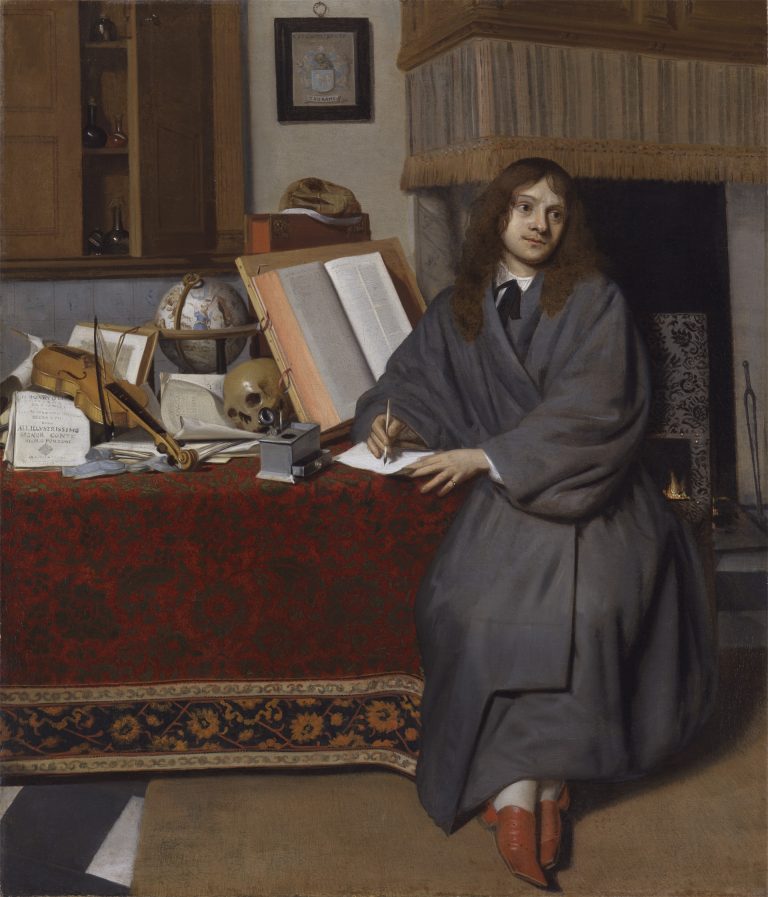Dr. Ysbrand Ysbrandsz, a pharmacist from a prominent Rotterdam family, is seen gazing wistfully to his left, having momentarily interrupted his writing to gather his thoughts.1 His personal motto, Circumspecte, visible on the coat-of-arms hanging on the wall, means “with caution” or “with meticulous care,” a highly appropriate sentiment for a pharmacist. His father had a successful career in the Dutch East India Company, even serving as its governor of the Coromandel Coast, the southeastern coast of the Indian subcontinent.2 Ysbrandsz trained for his profession at the medical school of the University of Leiden. Following his studies he returned to Rotterdam, where he married Maria Blaeu in 1664.
Ysbrandsz must have been well respected by his peers, because between 1667 (when he was 32 years old) and 1704 they regularly chose him to serve as headman of Rotterdam’s Apothecary Guild. Ysbrandsz may have commissioned Cornelis de Man to paint this portrait to celebrate his first election as headman in 1667. Apart from his professional leadership, Ysbrandsz was also active in municipal politics; from 1673 on he served on Rotterdam’s City Council, and in 1703 he was elected burgomaster.3
Ysbrandsz’s decision to have Cornelis de Man paint his likeness may well have been influenced by professional connections: De Man’s grandfather, uncle, and a cousin were pharmacists as well. Sometime in the 1670s, De Man included his uncle and cousin in a group portrait known as Three Pharmacists, which contains laboratory equipment and a view of an apothecary (fig 1). The Ysbrandsz and De Man families certainly would have known each other professionally, given that Cornelis’s family lived and worked in Delft, only fifteen kilometers from Rotterdam.4
Cornelis de Man, who became a member of the Guild of Saint Luke of Delft in 1642, travelled to France and Italy before settling back in Delft around 1653. He often merged portrait and genre traditions to depict professionals at work. This type of portraiture was first popularized in the Dutch Republic in the 1620s by Thomas de Keyser (1596–1667), as in his 1627 portrait Constantijn Huygens and His Clerk (fig 2).
Like De Keyser, Cornelis de Man had the ability to depict his sitters so that they seem thoughtfully and emotionally engaged in their work. De Man’s paintings have a remarkable clarity of style that not only comes from his mastery of perspective, but also from his ability to clearly define the shape and character of individual objects, in part through color.
In this striking portrait, De Man alludes to the range of Ysbrandsz’s scholarly interests through the objects in the still life on the table. A gleaming skull rests amidst various books and papers, a pictorial element that warns the viewer that life, which is finite, should be lived to its fullest. Ysbrandsz’s professional and public life confirm that he took this advice seriously. The violin indicates that music and the liberal arts were important components of his cultural life, but also shows that he knew how to relax and entertain. The text on the musical score next to the violin reads “All’Illustrissimo Signor Conte Nicolo Ponzoni,” identifying it as Tarquinio Merula’s Opus XVII. This score contains twenty-five songs for violin and viola that Merula dedicated to Niccolo Ponzoni, Count of Cremona, in 1651. Cremona had by that time already become famous for the violins produced by several generations of the Amati family, and for those by Nicolo Amati (1596–1684) in particular.5 It is intriguing to think that De Man’s painting could depict one of Nicolo’s celebrated violins.
The celestial globe on the table serves a dual purpose. In addition to reaffirming Ysbrandsz’s wide-ranging scholarly interests, the globe also pays homage to his wife, Maria Blaeu. Maria’s paternal grandfather, Willem Jansz. Blaeu (1571–1638), and uncle, Joan Blaeu (1596–1673), were internationally famous cartographers, whose globes and maps were prized for their accuracy and beauty.5 Willem Blaeu had produced his first of a series of celestial globes in 1597 and, based on its size and character, this Blaeu globe was made between 1602 and 1606.6 The globe as an attribute of learning also connects De Man’s painting to Johannes Vermeer’s slightly later paintings The Astronomer, 1668 (fig 3) and The Geographer, 1669 (fig 4). As with his Delft colleague, De Man’s depiction of his sitter’s quiet reflection is profoundly evocative.
